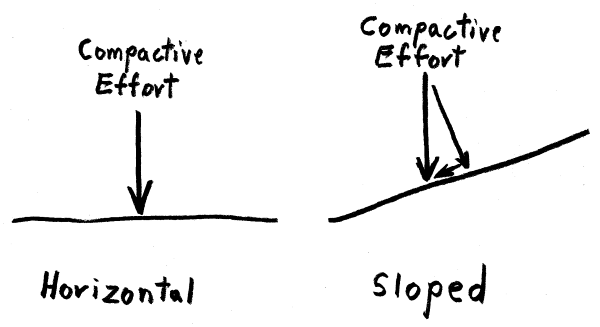geotechguy1
Civil/Environmental
- Oct 23, 2009
- 667
I've run into a few sites where my fellow geotechnical engineers have written specifications requiring uniform horizontal lifts. I've had some back and forth with different senior engineers but I'm still searching for a good reason for this specification and why they are so stringent on enforcing it.
Suppose you have a 6:1 slope, and you place and compact a uniform lift on the slope, with the same 6:1 slope. Why is that different than placing a uniform lift of the same thickness on horizontal ground? Usually these particular geotechs insist on placing overbuilt horizontal lifts on the 6:1 slope and then trimming them to grade at the end (imagine an overbuilt staircase of lifts if you would).
So, here's the million dollar question: Do the soil particles on the 6:1 slope know that they have been placed on a slope, and that they therefore are required to perform worse? Or do they only know that they've been compacted to whatever arbitrary percentage of SPMDD or MPMDD that particular consultancy has pulled out of their collective behinds?
As an aside, I always like asking them how they know compacting it to that percentage of SPMDD will achieve the shear strength and compressibility parameters they are looking for. No one has ever answered. I had one company that had assumed 1900 kg/m&^3 in a slope/w model, but all the fill was placed and compacted to 98% SPMDD, with a resultant of around ~1750 kg/m^3. Upon questioning the response was 'we know better than you'. Anyway, now I've gone off on a tangent.
Suppose you have a 6:1 slope, and you place and compact a uniform lift on the slope, with the same 6:1 slope. Why is that different than placing a uniform lift of the same thickness on horizontal ground? Usually these particular geotechs insist on placing overbuilt horizontal lifts on the 6:1 slope and then trimming them to grade at the end (imagine an overbuilt staircase of lifts if you would).
So, here's the million dollar question: Do the soil particles on the 6:1 slope know that they have been placed on a slope, and that they therefore are required to perform worse? Or do they only know that they've been compacted to whatever arbitrary percentage of SPMDD or MPMDD that particular consultancy has pulled out of their collective behinds?
As an aside, I always like asking them how they know compacting it to that percentage of SPMDD will achieve the shear strength and compressibility parameters they are looking for. No one has ever answered. I had one company that had assumed 1900 kg/m&^3 in a slope/w model, but all the fill was placed and compacted to 98% SPMDD, with a resultant of around ~1750 kg/m^3. Upon questioning the response was 'we know better than you'. Anyway, now I've gone off on a tangent.


![[idea] [idea] [idea]](/data/assets/smilies/idea.gif)
![[r2d2] [r2d2] [r2d2]](/data/assets/smilies/r2d2.gif)